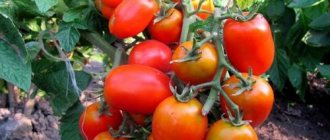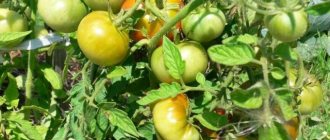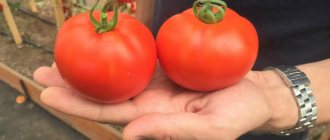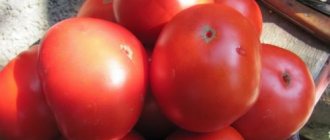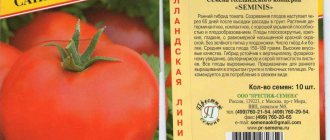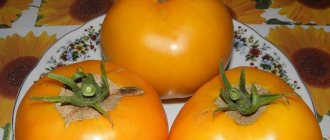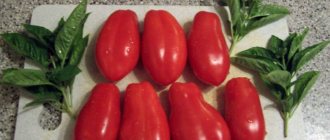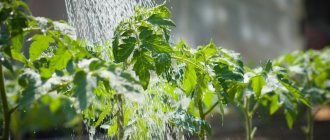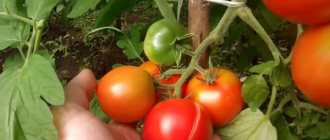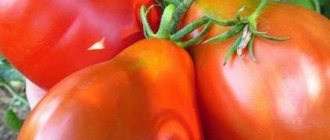» Vegetable growing » Tomatoes » Varietal features of the Sensei tomato
0
4410
Article rating
The Sensei tomato was developed in Siberia. It is engaged in the production of seeds. This variety is not included in the State Register of the country, but this does not prevent it from being popular among gardeners.
- Growing seedlings
- Seed preparation
- Soil preparation
- Sowing technology
- Picking seedlings
- Transplanting seedlings
- Care
- Watering
- Fertilizers
- Tying and pinching
- Disease and pest control
- Reviews from gardeners
Varietal characteristics of tomato Sensei
Why are early ripening and determinate varieties leading?
Well, what summer resident doesn’t dream of being the first to harvest a bountiful harvest of ripe, juicy and delicious tomatoes in order to show them off to his neighbors? It is quite possible to realize this desire by planting early or mid-ripening tomatoes in a greenhouse or in an open garden bed, but when doing this, you should remember their small disadvantages:
- As a rule, such varieties do not have high yields if they grow in the open air.
- They do not have that beloved sugar content that is present in later varieties of tomatoes. This is understandable, it is under the gentle sun that this amazing sweet and sour taste of tomatoes appears, and where can you get the abundance of its rays under the film of a greenhouse or under a still cool spring sky.
- Early varieties of tomatoes are not very tall and grow to a maximum of 25-30 cm.
- Their fruits are small in size.
This is how mid-season and early varieties of tomatoes are generally characterized, but not the Sensei tomato. Although it belongs to the standard and mid-season species, it is devoid of their shortcomings, and the reason for this is its origin.
Creation of the variety and scope of application
It's nice when a great harvest is achieved with a minimum of effort. As reviews from summer residents characterize the Sensei tomato, it is an unpretentious variety that does not require special attention. We need to thank agro breeders from Novosibirsk for this.
Scientists have tried to develop a variety that will live well in most regions of Russia, produce a high yield both in a greenhouse and in the open air, and have incredibly tasty and fairly large fruits.
Everyone who left reviews about the Sensei tomato variety assures that it is excellent in salads and in the preparation of first and second courses, dietary foods and natural juices.
Description of the plant
A special feature of this variety is its ability to adapt to environmental conditions. So, in a greenhouse, Sensei tomatoes (photo below) grow up to one and a half meters in height, while in open ground conditions - less than one.
The bushes of these tomatoes are compact, which is an extremely useful quality in a small greenhouse. As the description of the variety made by the producers themselves points out about the Sensei tomato, it cannot boast of thick greenery. Its leaves are small, dark green, and the fruits grow in a bunch of 3-5 pieces in one cluster.
Fruiting continues until autumn frosts. In the southern regions, the last green Sensei tomatoes are harvested in fields and garden beds at the end of October. The characteristics of the fruits are such that they ripen well at room temperature, no different from their “brothers” who have blushed under the rays of the summer sun.
Best reviews from our readers
- Raisa
City: GameManufacturer: Sibir Garden
Where grown: Greenhouse
Very sweet, productive variety, I have been planting for 6 years, large, I will plant again,
- Chuvyzgalova Tatyana
City: PermManufacturer: Siberian Garden
Where grown: Greenhouse
Very tasty. A lot of. We weren't sick with anything. I removed it at the end of September. Dense. Large, many as big as a fist. Not watery. The taste is reminiscent of a peach, but not sweet. I will definitely plant it next year.
- Miroshnichenko Elena
City: Belarus, urban settlement RussiaManufacturer: Tatyana Vlasova
Where grown: Greenhouse
Very tasty, juicy, sweet. I grew it for 2 years. I will continue, my whole family really likes them. The yield is average, but due to my still inexperience.
- Zhanna
City: Achinsk Krasnoyarsk regionManufacturer: Siberian Garden
Where grown: Open ground
I really liked the variety and have been planting it for three years. Large, tasty, beautiful. The first ones are larger, the rest are lighter in weight. Grow in open ground, without any shelter. I rolled it into slices, they kept their shape wonderfully and were delicious!
Description of fruits
As stated about the Sensei tomato, the characteristics and description of the variety available on the package with seeds, it has ideal, slightly elongated raspberry-colored fruits, reminiscent of a huge strawberry. They have smooth and dense skin, soft and juicy pulp, in which there are practically no seeds.
If you believe what consumer reviews say about the Sensei tomato, the weight of each tomato is approximately 450 g. This puts it in the category of large-fruited varieties that are very attractive for preparing salads. Also, this size of the fruit is convenient for preparing fresh or canned juices. This is facilitated by the sugary pulp with a refreshing rich taste.
On the other hand, an ovary of 4-5 tomatoes of this weight creates a very large load on the stem of the plant, so it definitely needs support. As the practice of gardeners confirms, the yield of up to 8 kg per 1 square meter, which is produced by the Sensei tomato variety, makes it very attractive for growing in small greenhouses or plots.
Characteristics and description of the Sensei tomato variety, its yield
Siberian breeders developed the Sensei tomato, the variety description of which states that the formed bush retains the ability to bear fruit until the onset of cold weather. The Sensei tomato variety is intended for cultivation in any region of the country, but a more favorable environment is being formed in the southern regions. To grow Sensei in the north, you need to plant the plant in greenhouse structures.
Main characteristics
Characteristics and description of the Sensei tomato variety has basic features. Many summer residents who grew this variety claim that the tomato has the following characteristics:
- the height of the bush, provided it is planted in greenhouses, can reach a height of 150 centimeters, and in open ground - 100 - 110 centimeters;
- the variety is distinguished by its large fruit;
- tomatoes belong to the early group;
- characteristics of tomatoes Sensei claims that tomatoes are resistant to popular diseases;
- tomatoes are resistant to low temperatures;
- Tomato productivity is high: from 1 square meter you can harvest an average of 6 - 8 kilograms of vegetables;
- the fruits have a bright, red-raspberry skin;
- the shape of the fruits of tomatoes of the Sensei variety is heart-shaped;
- the skin of the fruit has a smooth surface;
- unripe fruits ripen well at home;
- the average weight of ripened Sensei tomatoes ranges from 300 to 500 grams;
- the pulp of fruits that have reached maturity has a fleshy structure, a small amount of seeds;
- the fruits have a sweetish, pleasant taste.
Thanks to these qualities, ripe fruits are used to make salads. Tomatoes are often used in the preparation of various sauces and tomato pastes. Housewives who often prepare tomato juice claim that the juiciness of ripened fruits allows them to prepare a rich, tasty drink with a sweetish aftertaste.
The Sensei tomato, the majority of which have only good reviews, has one drawback: the summer resident who has already planted these tomatoes noticed their attachment to the need for a large amount of fertilizing. No other deficiencies were identified in the variety.
Growing conditions
The Sensei tomato variety is distinguished by its ease of care. Sowing work should begin in mid-March or early April. Many housewives carry out seed disinfection procedures before sowing, but this is not necessary, since the manufacturer carries out all the necessary procedures by default.
To grow healthy seedlings, seeds should be sown correctly.
- The first step is to soak them in a growth stimulator. The seeds should be kept in this composition for 12 hours. If the housewife does not have such a substance, you can replace it with fresh aloe juice.
- Prepared seeds are planted in depressions at a distance of 2 centimeters from each other.
- Then the soil is moistened, the container is covered with polyethylene or a piece of glass. Such material will create a favorable environment for the growth of seedlings of the Sensei variety.
- The container is moved to a warm, bright place.
- After the first shoots appear, the covering material is removed.
- When 2 leaves have formed above the ground, the seedlings should be planted in peat pots.
Sensei seedlings can be planted in open ground only after the soil has warmed up and the night frosts have ended. No more than 3–4 bushes are planted per 1 square meter.
Features of transplantation and care
To grow a healthy plant and get a rich harvest, you must follow the correct procedure for transplanting the plant into the soil. Transplantation into open ground should be done when the environmental temperature approaches the optimal values of 22 - 25 degrees. Landing should be carried out taking into account the following instructions:
- Before transplanting, the soil is loosened, and then holes are formed in it.
- Mineral phosphorus fertilizer is poured into each hole.
- Then the seedlings are placed in the formed depression directly in the pot.
- The transplanted plant is watered with settled water. Watering should be done only at the root, avoiding liquid getting on the plant itself.
Transplanted plants require regular application of liquid fertilizers. After planting the bush, it needs to be provided with the following care:
- watering should be provided in the morning once a week;
- when watering, use a spray bottle or watering can with small holes;
- watering is carried out only at the root;
- in the hot season, the optimal water temperature for irrigation is 18 degrees, and in cool seasons - 25;
- Bushes should be formed into 1 or 2 stems;
- stepsons must be removed;
- the formed bush must be tied to support structures created in advance;
- To grow sweet aromatic fruits, you need to feed the plant 4 times a season: you need to use fertilizers that are either organic or mineral containing potassium and phosphorus.
If all the listed care rules are followed, the Sensei variety will pamper the summer resident with delicious fruits that can be preserved until winter if they are collected during milk ripeness.
Possible diseases and pest damage
Tomatoes of the Sensei variety have excellent immunity to a huge number of tomato diseases. However, summer residents who regularly grow this variety recommend taking preventive measures that completely eliminate the risk of damage to the plant.
To do this, you need to regularly remove all weeds from the beds. If cultivation is carried out in a greenhouse, it should be regularly ventilated, and the soil and structure should be treated with specialized antifungal drugs.
Sensei tomato foliage should be inspected regularly to prevent insect damage. When pests appear, it is necessary to begin combating them as early as possible. To eliminate slugs, you can use ammonia: the pest is removed from the leaf, and then the affected area is wiped with a solution of ammonia.
If tomatoes are attacked by flying pests, it is necessary to treat them with specialized chemicals.
Despite the fact that Sensei tomatoes were registered not so long ago, tomatoes are already very popular among summer residents. Such demand is determined by obtaining a rich harvest that has an attractive appearance, attractive aroma and excellent taste.
The advantages of this variety
As a rule, the popularity of a particular type of vegetable is influenced by factors such as taste, yield and care requirements. If we talk about the Sensei tomato variety, its characteristics indicate that it contains all the listed requirements.
- Firstly, it is good for all regions of the country.
- Secondly, the quality of a tomato of this variety does not change depending on whether it grows in an open garden bed or in a greenhouse.
- Thirdly, he knows how to adapt to terrain conditions. It “feels” equally well in both dry and rainy summers.
- Fourthly, this is a high-yielding and large-fruited variety.
- Fifthly, as Sensei says about tomatoes in the description of its fruits, they have unusually juicy, tasty and refreshing sugary pulp.
- Sixthly, the variety is resistant to almost all diseases that nightshades may suffer from.
Important: in order to get good results from this type of tomato, you should take into account the requirements that it makes when caring for it.
Where is the best place to place Sensei?
Like other nightshades, this variety “presents” several requirements for choosing a place.
- It cannot be planted where potatoes or eggplants previously grew, but it will like it in the garden after onions, cabbage, carrots and zucchini. Also, you should not plant seedlings or sow seeds in the same place for two years in a row. At a minimum, 3 years should pass between sowings.
- Land with a lot of organic matter is not suitable for him. Although the Sensei tomato is demanding when it comes to feeding, too much of it is just as harmful to it as too little.
- This variety needs space, especially in open ground, so you need to select in advance a place where its bushes will be planted at a distance of at least 45 cm from each other.
- Neither too dry nor too wet soil suits it. The Sensei variety loves moderation in everything.
- You can't deprive him of the sun. Shaded beds will slow down the growth of tomatoes, which will affect both the quality of the fruit and their size.
To truly enjoy this variety of tomatoes, you should fulfill these minor requirements and provide it with enough space and sun.
Planting seedlings in a permanent place
Seedlings are planted in a permanent place when at least two months have passed from the date of sowing the seeds. This is done when the air and ground are stably warm and there is no threat of frost. Seedling beds are prepared ahead of time in the fall, adding humus and wood ash to the soil.
The areas that were previously intended for growing are best suited for tomatoes:
- cabbage;
- cucumbers;
- salad;
- beets;
- carrots;
- Luke;
- legumes;
- melon crops.
It is not recommended to use areas where the following were previously grown for tomato plantings:
- potato;
- eggplant;
- tobacco;
- tomatoes;
- pepper.
Important! Not only should tomatoes not be planted in the same place the next year, this should not be done until 3 years have passed.
In addition, areas located on a hill and reliably protected from the winds should be allocated for tomato beds. The distance between tomato bushes is at least 45 cm.
The depth of the holes should be such that after placing an earthen ball with the root system in them, the soil poured on top reaches the cotyledon leaves. After planting, the seedlings should be immediately watered with warm water.
Soil preparation
If “the sleigh has been prepared since the summer,” then the soil for planting tomatoes should be fertilized in the fall. Only in this way by spring will it become truly suitable for tomatoes, which really love soil saturated with beneficial minerals. Experienced gardeners advise liming the soil, as this will add substances important for tomatoes such as magnesium and calcium. This procedure is carried out exclusively in the fall, so that rain and snow have time to dissolve the lime and the soil to absorb it.
Some vegetable growers prefer to apply fertilizers in the spring; in this case, future tomato beds simply need to be dug up in early autumn to a depth of no more than 20 cm. This will make it easier to apply fertilizing to the ground when digging with the onset of warm weather.
Important: mineral fertilizers and humus will be enough to prepare the soil, but in the spring they should be applied 2 weeks before sowing. Also during this period, it is recommended to treat the soil with a solution of copper sulfate to protect the plants from pests. When the time comes to plant seedlings, the same fertilizers are added to the holes as when digging.
Seed preparation
Tomato Sensei can be sown or planted as seedlings. Seed preparation is carried out at the end of March - beginning of April, and it begins with soaking them in a growth stimulator. Those who do not trust store-bought products can use aloe juice, but only freshly squeezed. It is enough to keep the seeds in the solution for 12 hours so that they sprout together after sowing.
Many gardeners prefer to germinate seeds in advance so that they grow faster. This really speeds up the process, but it is only permissible in places where there are no late frosts. More experienced vegetable growers advise alternating sprouted and dry seeds in the hole. If frosts happen, and the first ones have already sprouted, the second ones haven’t even hatched yet, which will save the harvest.
Important: if you compare the quality of tomatoes planted with seeds and seedlings, then often the former catch up with the latter in growth, but at the same time they are stronger and more resistant to weather changes and pests.
Sensei seeds do not need any other preparation, since manufacturers neutralize them in advance.
Growing seedlings
As a rule, tomato seeds of this variety are sown for seedlings 1.5-2 months before planting them in the garden. In order for them to germinate well, it is necessary to create suitable conditions for them:
- You can prepare the soil with your own hands or buy ready-made peat in the store, but both should be calcined or steamed to neutralize it. Seedlings of the Sensei variety, although unpretentious, like all other plants, can be subject to stress if not properly cared for, which makes them vulnerable to fungus.
- Sowing of seeds is carried out in furrows on fertilized soil at a distance of 1 cm. If they are large enough, then this procedure can be carried out with tweezers.
- Sprinkle the seedlings with soil, water and cover with film.
Important: you need to maintain the temperature under the film at +20 degrees until the seeds hatch. As soon as this happens, the film is removed, and the sprouts only need watering and warmth.
It is best to place containers with seedlings on the windowsill on the sunny side. As soon as the plants have true leaves, they can be transplanted into separate pots.
Picking seedlings
Despite the fact that they say about Sensei tomatoes (characteristics and descriptions of varieties, reviews about them confirm this) that they are unpretentious and not particularly demanding, you need to grow seedlings for planting correctly. Picking is an important part of the process.
When the leaves appear on the sprouts, they become cramped in the common container, so the first transplant in their “life” is carried out.
- Prepare pots, soil and mineral fertilizer. You can use a complex composition at the rate of 1 tbsp. l. per 5 liters of water, or dilute a special mineral product for tomatoes in the proportion indicated on the label.
- In an individual pot, you need to make a hole of such depth that the plant fits in it down to the cotyledon leaves.
- Fertilizer is poured into the hole and the plant is planted.
After 2 weeks, the seedlings can be fertilized again. Water the plants as the soil in the pots dries out.
Planting and care
In order for the seeds to germinate faster and more fruits to form, it is necessary to use growth and development stimulants. Before planting, seeds are soaked in a solution:
- drop of Epin,
- 50 ml water.
The holding time of the seed in the stimulator is 2-4 hours.
The soil should be shed with a strong solution of potassium permanganate - this is both potassium fertilizing and disinfection. The seeds are sown in furrows at a distance of 3 cm from each other, covered with sifted soil, and carefully watered. Before the shoots appear, it is better to cover the box with glass or film.
The plants are kept in a common box until their third true leaf begins to form. Then the seedlings are planted into separate containers with a volume of 0.4-0.5 liters.
The seedlings will have to grow in pots for almost 2 months, so the volume of the containers should not be small.
The seedlings are kept at a temperature of 20-23 degrees and, if necessary, receive additional lighting. The appearance of purple color on the leaves is acceptable. She says that the seedlings survived the effects of cold and acquired immunity to it.
During the growing season, the bushes should be sprayed once or twice with Epin (1 ml per 5 liters of water).
Feeding:
- beginning of growth in open ground – 1 tbsp. spoon of urea per 10 liters of water per 2 square meters. m;
- formation of fruits on 1-2 clusters – 1 tbsp. spoon of azofoska per 10 liters of water per 2 square meters. m;
- mass fruit setting - spraying the leaves with potassium humate (two tablespoons per 10 liters of water).
Recommended tomato varieties
Tomato care
Even taking into account the fact that the Sensei variety is quite resistant to cold weather, the seedlings should be planted in a permanent place when the weather has already warmed up and the earth has warmed up well.
As a rule, it does not require much care:
- The Sensei tomato needs moderate watering, which is why it is so suitable for summer residents who can only come on weekends. Irrigation is carried out once a week at the root, for which it is better to use a watering can with a fine mesh.
Important: you need to avoid getting moisture on the leaves so that they don’t burn in the sun, and the water temperature should be at least +18 in hot weather and +24-26 degrees in cool weather.
- Fertilizing is carried out 4 times per season, alternating organic matter with mineral fertilizers.
- Sensei's bushes need shaping. Stepchildren should be removed, forming a plant of one or two stems.
- As the fruits form, the Sensei tomato needs to be tied to a support, since the stem may break under their weight.
This is all the care for this tomato variety.
Outdoor care
Seedlings planted in a permanent place require subsequent painstaking and systematic care.
Watering
Tomato variety "Sensei" is content with moderate watering, which is best done in the mornings or evenings. You should not use tap water for watering with a hose, since cold water has a stressful effect on tomatoes.
Therefore, water that has been settled and heated in a barrel is often used for irrigation. For the first time, seedlings planted in a permanent place are watered after a week. Until the plant blooms, it is watered every 3 days, pouring 3 liters of water under each bush.
After the inflorescences and ovaries appear, the watering rate increases to 5 liters for each bush, but the frequency decreases to once a week. Pour water exclusively under the bush.
Important! During fruit formation, the intensity of watering should be reduced.
Fertilizer application
This variety of tomatoes is very demanding when it comes to fertilizing and at the same time noticeably responsive to the application of fertilizers. Therefore, “Sensei” is fed repeatedly during the growing season, varying both the composition of fertilizers and the method of their application.
10 days after planting the seedlings in open ground, they are first fed with superphosphate and potassium sulfate, which 35 g of each is added to a bucket of water. With the help of phosphorus, the root system is strengthened, and potassium has a positive effect on the taste of the fruit.
The development of green mass is well influenced by nitrogen, which is abundant in organic fertilizers.
When the plant blooms, it is sprayed with a solution of boric acid, which is prepared by adding 10 g of the drug to a bucket of water. This operation prevents the inflorescences from falling off and activates the appearance of ovaries.
During the period of growth and ripening of fruits, excess nitrogen only hinders this process, so fertilizing with organic matter must be stopped and emphasis should be placed on fertilizers containing:
- potassium;
- phosphorus;
- iodine.
A folk remedy in the form of wood ash, which is saturated with potassium, magnesium, calcium and other minerals that are so popular in tomatoes, is useful in this regard.
Stepsoning
In this tomato variety, stepsons are quite actively formed in the leaf axils, which create excess green mass, which deprives the plant of the nutrients necessary for the formation and growth of fruits. Therefore, starting in July and every 10 days, pinching is carried out.
Foliage is completely removed from the lower tier, and, if necessary, partially from other tiers. The green mass should not prevent sunlight from reaching the fruit. The stepsons are broken off with fingers disinfected with a weak manganese solution. Experts do not recommend using scissors when pinching.
Soil care
The “Sensei” tomato responds well not only to fertilizing, but also to loosening the soil above its roots. It is recommended to carry out this procedure every time after watering, but at least once every half month. In parallel with loosening, weeding is also carried out.
During loosening, in order not to harm the root system, during the first month of plant growth in open ground it is necessary to go deeper into the soil no more than 12 cm, and after that this depth is reduced to 8 cm.
In order to create optimal temperature and humidity conditions in the root system of tomatoes, it is also necessary to hill up the bushes using moist soil or replace this process by mulching the root soil with humus.
Tying up bushes
Bushes of the "Sensei" variety have one or two powerful stems, which, with a relatively small height and moderate density of green mass, at first often do without a garter.
However, when the fruits ripen, which weigh on average up to 0.4 kg each and there are up to 5 pieces in the clusters, you have to resort to tying with the help of stakes or trellises driven in next to the bushes.
Branches with tassels hung with tomatoes are tied with cords with a low stiffness coefficient also so that the fruits have better access to sunlight, and the fruits themselves do not come into contact with the soil and do not become infected from it.
Find out how to properly tie tomatoes.
Preventative treatment
Sensei tomatoes are resistant to:
- tobacco mosaic;
- Alternaria;
- late blight;
- verticillium wilt;
- fusarium.
That is, to all those diseases that most often affect nightshade crops. Successfully repels “Sensei” and pest attacks. However, this does not mean that these tomatoes are completely protected from diseases and pests.
Therefore, plants require preventive human help to avoid being attacked by, for example, aphids, Colorado potato beetles or spider mites.
To do this, the vegetable grower needs:
- At least once a week, inspect the leaves from the reverse side.
- Weed regularly.
- When flying pests appear, spray the bushes with insecticides.
- Spray plants with antifungal biological agents.
- If you find slugs, immediately collect them with your hands and treat the bush with ammonia dissolved in water.
Top dressing
Today, in specialized stores you can buy ready-made fertilizer for tomatoes, although many gardeners prefer to do it the old fashioned way and prepare the fertilizer themselves. The Sensei tomato requires high-quality nutrition, without which it will not form fruits of this size. You can use it as:
- For the first feeding, mineral fertilizers containing phosphorus and potassium are suitable. It is carried out 2-3 weeks after planting the seedlings.
- Fertilizers are applied a second time when the second cluster of tomatoes blooms. It is good to use organic matter during this period, for example, mullein, diluted in a ratio of 1 to 10.
- The third feeding is the same as the second, but is carried out after the next cluster blooms.
- In the fourth approach, it is better to use foliar feeding. During this period, it is important to preserve all the flowers, so you can spray the plant with mineral fertilizers. To do this you need to take 1 tsp. per 1 liter of water with the addition of half a microfertilizer tablet.
By fertilizing the Sensei tomato in a similar manner, you can expect a large harvest of large and juicy fruits.
Currently, many gardeners have already discovered the advantages of this variety, and every year it gains more and more fans.
Diseases and pests
The tomato variety “Sensei” has excellent immunity to characteristic tomato diseases. It is not afraid of late blight, Fusarium or Verticillium wilt, Alternaria, and tobacco mosaic. Nevertheless, it is recommended to carry out preventive measures to prevent the occurrence of diseases:
- Regular ventilation of greenhouse structures;
- Timely weeding of beds;
- Preventive spraying of plantings with antifungal bio-preparations.
No less dangerous to tomatoes are pests that cause significant damage to plants. The most common are Colorado potato beetles, aphids, thrips, and spider mites. For timely detection of pests, it is necessary to periodically inspect the plantings, looking under the leaves. To destroy flying insects, the use of potent insecticidal preparations is effective, after 2-3 treatments. Slugs are collected manually, and then the bushes are sprayed with an aqueous solution of ammonia.
